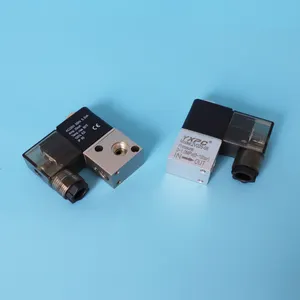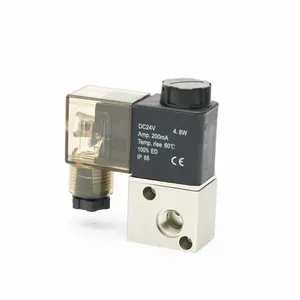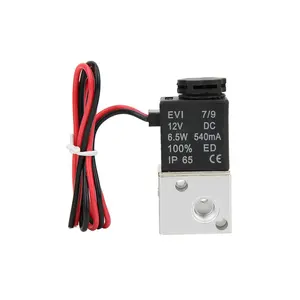
All categories
Featured selections
Trade Assurance
Buyer Central
Help Center
Get the app
Become a supplier

(2104 products available)




























Solenoid valves come in various configurations, each serving specific functions and applications. The following are the most common types:
Direct Acting Solenoid Valves
A direct acting solenoid valve works by using the magnetic field generated by the solenoid coil to directly open or close the valve. This type of valve is especially useful for low-pressure applications because they can operate without requiring differential pressure to move the valve mechanism. Their simplicity makes them ideal for small systems where precise control of fluid or gas is necessary.
Indirect (Pilot Operated) Solenoid Valves
While a pilot solenoid valve's coil opens a small pilot orifice, pressure moves the main valve diaphragm or piston. In essence, pilot solenoid valves use the principle of differential pressure. Unlike direct acting valves, pilot operated solenoid valves are meant for large valve applications with high pressure, such as boilers or heat exchangers. The pilot valve requires lower coil energy to toggle its position. Therefore, these valves tend to be more energy efficient, especially for prolonged use.
2 Way Solenoid Valves
A 2 way solenoid valve has two ports and is responsible for fluid or gas on-off control. When de-energized, the valve's natural position is to block the flow. On the other hand, when energized, the valve shifts to allow fluid or gas to flow through. In other words, 2 way valves are used to control the flow direction of fluids or gases. Common applications include refrigeration systems, irrigation systems, and industrial automation.
3 Way Solenoid Valves
As the name goes, a 3 way solenoid valve has three ports and can both divert and mix fluid or gas. These valves are most commonly used in pneumatic systems. In one configuration, the valve will route an incoming fluid or gas to one of the two outgoing ports. In another configuration, the valve will allow fluid or gas from both the incoming and outgoing ports to mix and discharge through a common port. This versatility makes 3 way solenoid valves essential components in complex fluid control systems.
Normally Closed (NC) Solenoid Valves
A normally closed valve is closed when de-energized. Meanwhile, an NC valve is open when it is energized. Thus, NC solenoid valves are responsible for blocking fluid or gas when there is no electrical current. On the other hand, they allow flow when electrical current is available. This characteristic makes them ideal for safety applications. Their natural state of closure helps prevent unintentional leaks or releases in critical systems such as chemical processing plants and medical equipment.
Normally Open (NO) Solenoid Valves
Conversely, normally open solenoid valves are open when de-energized. Alternatively, they close when energized. This feature allows these valves to shut off the flow of fluid or gas when electrical current is present. Normally open valves are often applied in situations where power failure should result in flow cessation. For example, they are used in emergency shutdown systems.
The durability of solenoid valves varies with the materials used to construct their internal and external components. These materials need to be sturdy enough to handle the conditions of the intended environment.
Brass
Brass is one of the most common materials used to make solenoid valves. This is because it possesses a great balance between strength, corrosion resistance, and cost. As such, brass valves are well-suited for medium to low-pressure applications in both industrial and commercial settings. Moreover, the copper content in brass provides excellent resistance against corrosion. This is especially so in water-related applications. Therefore, brass solenoid valves are very durable in both oily and watery environments.
Stainless Steel
Although not as widely used as brass, stainless steel solenoid valves offer superior durability. This is especially so for harsh and corrosive environments. Stainless steel is a solenoid valve material that is ideal for applications involving chemicals, steam, or extreme temperatures. This is because stainless steel is corrosion-resistant and exceptionally robust. In fact, even with long-term use, they are less likelier to develop leaks or failures. Common industries that use these valves include oil and gas, food and beverage, and water treatment.
Plastic
For applications that require high resistance to corrosive chemicals or moisture, plastic solenoid valves are recommended. Plastic materials such as polypropylene and polyamide are used in these valves. They are lighter in weight and more affordable than metal counterparts. They are also very durable. However, in high-temperature applications, plastic may be less durable than metal. Nonetheless, plastic valves are essential in the chemical processing, wastewater treatment, and irrigation industries.
Aluminum
Aluminum solenoid valves are lightweight and possess high strength. This makes them ideal for pneumatic applications, automotive systems, and any other space where weight is a crucial factor. However, while offering reasonable corrosion resistance, aluminum is less corrosion resistant than stainless steel. To mitigate this drawback, aluminum valves are often coated with protective materials. With such coatings, their longevity in humid or chemically aggressive environments is greatly enhanced.
Coatings and Seals
In long term usage, coatings and seals are very important in helping solenoid valve components retain their integrity. Anti-corrosive coatings such as PTFE (Teflon) or epoxy are applied to metal valves to prevent corrosion in chemically aggressive environments. Also, seals and gaskets made from materials like NBR (Nitrile Rubber) or Viton are essential in maintaining a valve's durability. This is because they prevent internal wear, especially in applications involving high temperature or aggressive chemicals. Periodic replacement of these seals also ensures the solenoid valve maintains a long operational lifetime even in harsh environments.
Solenoid valves are crucial components in many industrial and commercial operations. Below are these applications wherein these valves control fluid and gas effectively:
Industrial Automation
Industries frequently use solenoid valves in their automation systems. Controlling actuators, cylinders, and other equipment is one application of the valves in this context. The key advantage of using these valves in automation processes is that they are remotely operated. This makes it easy to integrate them into computerized control systems. In the manufacturing sector, for example, these valves control lubricants, air, and other essential fluids. Without these valves, there would be no precision and efficiency in these control mechanisms. Overall, in industrial automation systems, 2 way and 3 way solenoid valves are commonly used.
Hydronic and Pneumatic Systems
Solenoid valves are integral to hydronic (water-based) and pneumatic (air-based) systems, in which they control fluid and gas, respectively. In HVAC (Heating, Ventilation, and Air Conditioning) systems specifically, these valves regulate refrigerants and other operating fluids. They also help with fluid and gas control in building and pipeline transport systems. Furthermore, their ability to handle high pressure and flow makes pilot operated solenoid valves ideal for these heavy-duty applications.
Irrigation Systems
A common application of solenoid valves are automated irrigation systems in the agricultural sector. These valves control the distribution of water to crops. By doing so, they ensure optimal water supply for plant growth. NC solenoid valves are particularly useful in irrigation because they can hold water back when there is no electrical current. This feature prevents overwatering and wastage of water in the process.
Medical Equipment
Another critical application of solenoid valves are in medical devices. For instance, they are used in ventilators, anesthesia machines, and fluid delivery systems to control gas and liquid medication flow. These valves have to be very reliable, accurate, and made of bio-compatible materials. Such features ensure that they are hygienic so as not to be contaminated with germs. Only direct acting solenoid valves are used in medical applications due to their ability to operate with low pressure and without having to rely on the flow of gas or liquid.
Industrial and Residential Boilers
In both industrial and residential settings, solenoid valves are used to control steam and water in boilers. A key application of these valves in this context is in safety systems. Here, the valves are responsible for shutting off fuel supply in case of any malfunction. This feature makes in demand these valves for applications involving high temperatures and pressure, such as steam systems. Pilot operated solenoid valves are frequently employed here because of their ability to handle high pressure and flow rates.
Choosing the right solenoid valve for an application requires careful consideration of several factors. Below are these factors:
Medium
The medium to be controlled by the solenoid valve has a huge impact on which material to make the valve from. For example, while a brass solenoid valve suffices in most industrial applications, a stainless steel valve is recommended for high-temperature solenoid valve applications or those that deal with chemical corrosion. The medium to be controlled can be anything from chemical liquids or gases, steam, water, and air to a myriad of other fluids.
Pressure and Temperature
Every solenoid valve has its pressure and temperature rating. Therefore, check if these parameters in the application do not exceed the valve’s rating. If they do, then the best course of action is to go for a valve rated for higher pressure and temperature. Also, the required operating pressure and temperature must be compatible with the potential solenoid's electrical coil. These are critical to ensure proper valve operation.
Electrical Requirements
A solenoid coil's voltage and current should be compatible with the available power supply in the application. There are two main types of coil voltage to choose from: AC (Alternating Current) and DC (Direct Current). Most coils are available in both voltage types. However, there are specific applications like automotive that require DC coils. Note that different coil materials have different magnetic and thermal properties. These properties also influence the choice of solenoid valve.
Valve Size
The valve size must be big enough to ensure efficient flow. At the same time, it should not be overly oversized so as to avoid wastage. Therefore, to determine the appropriate valve size, measure the flow rate of the medium in the application. Then compare this flow rate with the valve port size. The two should be compatible.
Application
The final key consideration is the specific application. In other words, is the solenoid valve for industrial automation, HVAC, medical equipment, or irrigation? Normally, specific applications have specific requirements. For example, NC solenoid valves are ideal for irrigation and safety applications. Conversely, 2 way and 3 way solenoid valves are commonly used in industrial and pneumatic systems, respectively.
A1. The operational principle of a solenoid valve is electromagnetic. When an electric current passes through the coil, a magnetic field is generated. This magnetic field attracts the armature. The armature then moves, opening or closing the valve mechanism. This process allows fluid or gas to either flow through or be blocked, depending on the valve type.
In industrial automation, for instance, solenoid valves serve the purpose of controlling actuators and cylinders. They offer an easy method to integrate into computerized control systems. In addition, one type of solenoid valve, specifically direct acting solenoid valves, can operate under low pressure. This makes them suitable for industrial automation applications.
A3. Solenoid valves are High pressure application compatible if they are pilot operated solenoid valves. These valves use pressure to open and close the valve, thus making them suitable for high-pressure applications. Direct acting solenoid valves, on the other hand, are unsuitable for high-pressure applications due to their low-pressure operating requirement.
A4. Normally closed solenoid valves stop medium flow when electrical current is not available. Vice versa for normally open valves. NC valves are commonly used for safety applications. This is because they prevent medium leakages when there is a power outage. Conversely, normally open valves are suitable for applications that require medium flow to cease during an outage.
A5. Maintenance requirements for solenoid valves are mostly about caring for the coil and regularly inspecting the valve. To maintain the coil, ensure there is no excess current. Also, ensure to regularly check for any medium deposit clogging valve ports and damaging internal parts. Furthermore, if there are seals, ensure to replace them once they show signs of wear or damage. In doing all these, solenoid valve durability is enhanced.